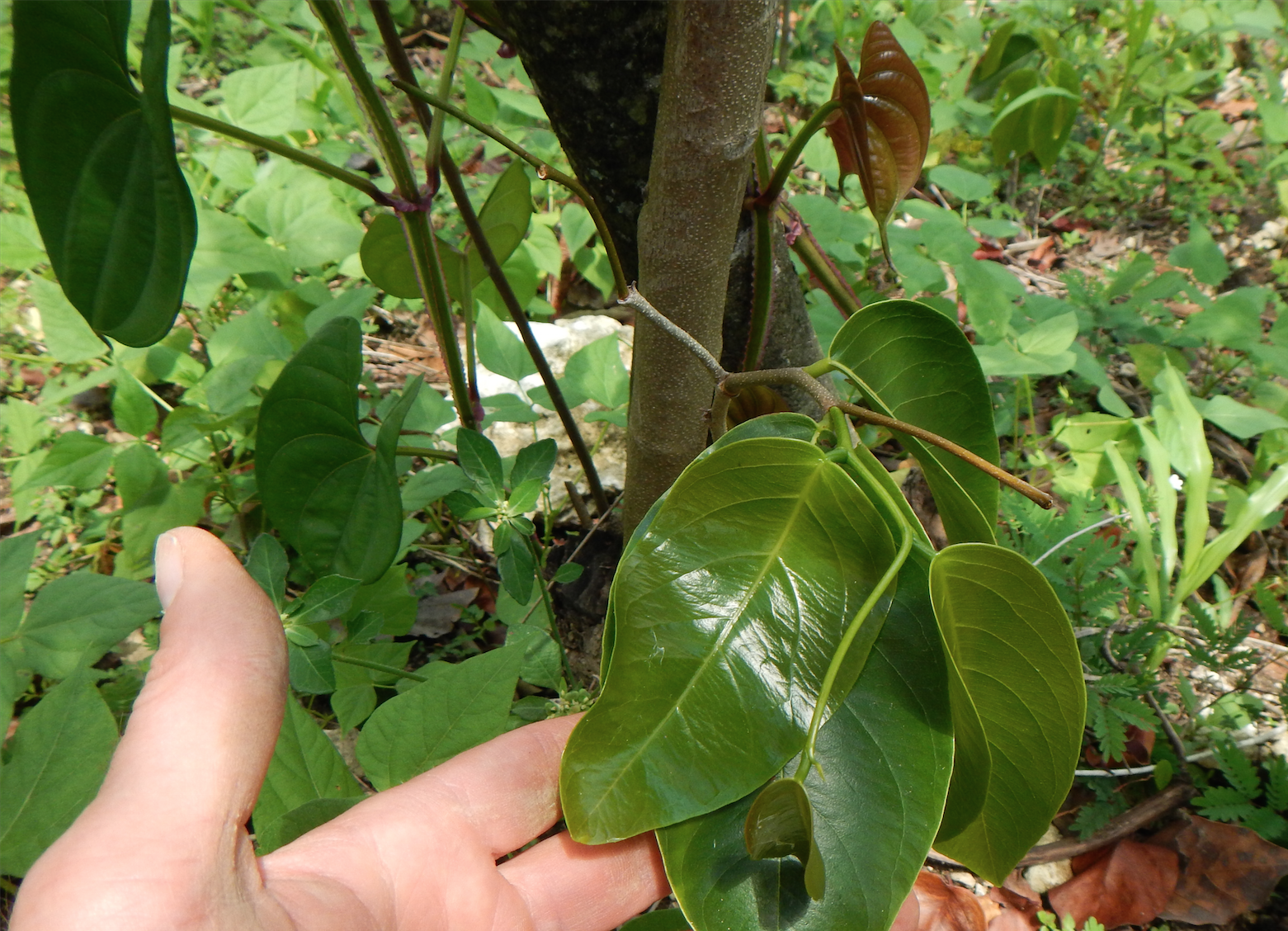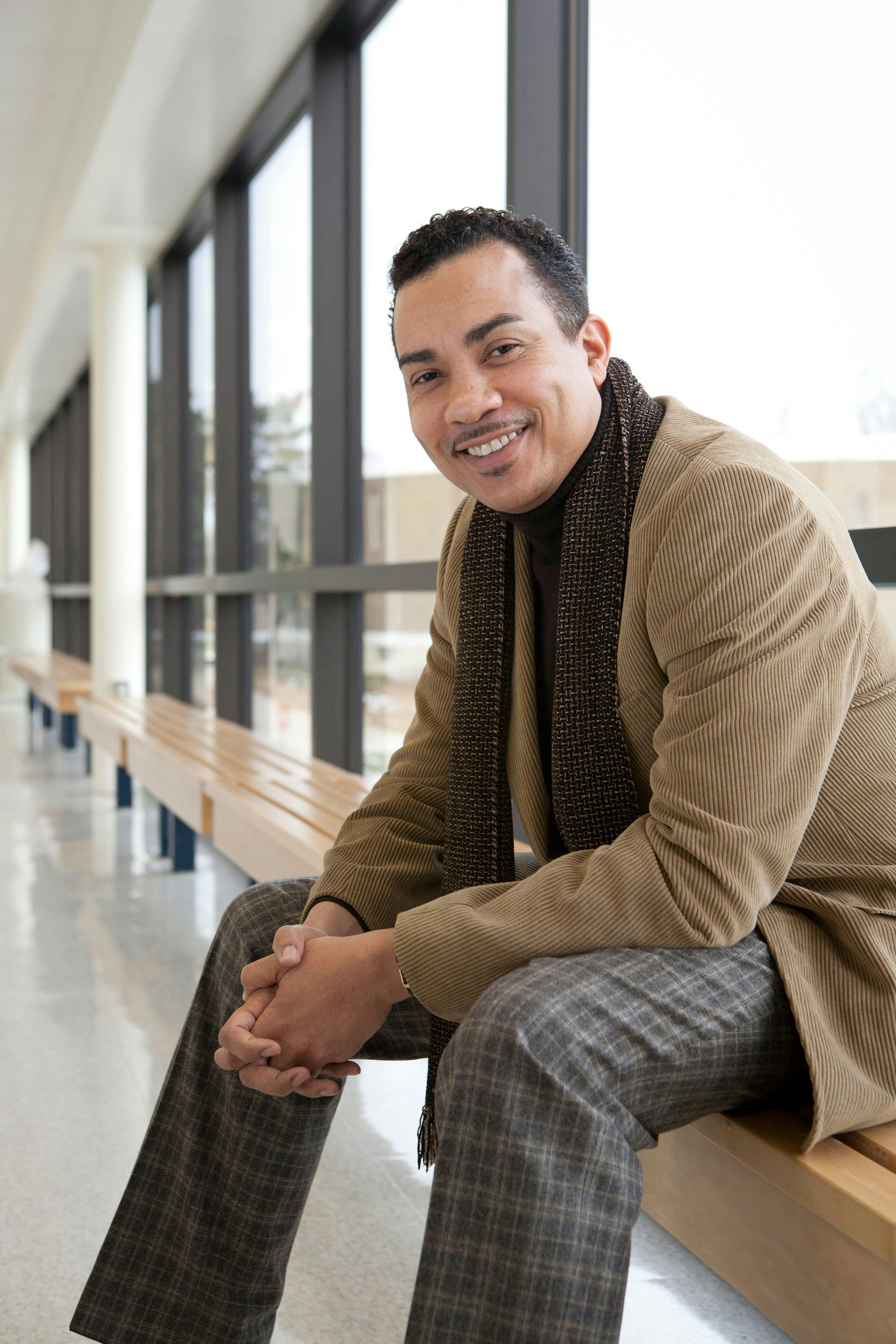Jamaicans have long had a close relationship with plants and their environment. As in many regions of the African Diaspora, African slaves in colonial Jamaica used their ethnobotanical knowledge to develop cultural traditions. Despite white supremacy and colonialists' attempts at cultural annihilation through barbarous conditions of chattel slavery, plant materials were used by enslaved people for medicinal, spiritual and dietary purposes and to produce useful objects such as baskets, hats, household accessories and clothing. One such ethnobotanical tradition that captured public attention at international exhibitions and world's fairs, and offered an intriguing insight into the lives of enslaved and freed Jamaican women, was the use of Jamaican lace-bark in the manufacture of clothing.
Clothing and textiles were valuable commodities in the lives of enslaved Africans in colonial Jamaica. Most slaves received from their owners ‘as much Oznaburgh as will make two frocks, and as much woolen stuff as will make a great coat’ (Stewart 1823: 269).^1^ The clothing allowance was insufficient for many slaves. Intense work under harsh weather conditions combined with weathering of garments destroyed the paltry clothing rations they received (Higman 1995: 224-5). Further, local statutes did not stipulate equal distribution of clothing between enslaved men and women. Consequently, enslaved women often received less than male slaves and were expected to supplement their annual clothing rations. Several slave women stole clothes from their enslavers (Bush 1990: 61). Some offered sexual favours in exchange for garments while others purchased additional clothing with money saved from selling produce from their vegetable gardens (Foulks 1833: 107).
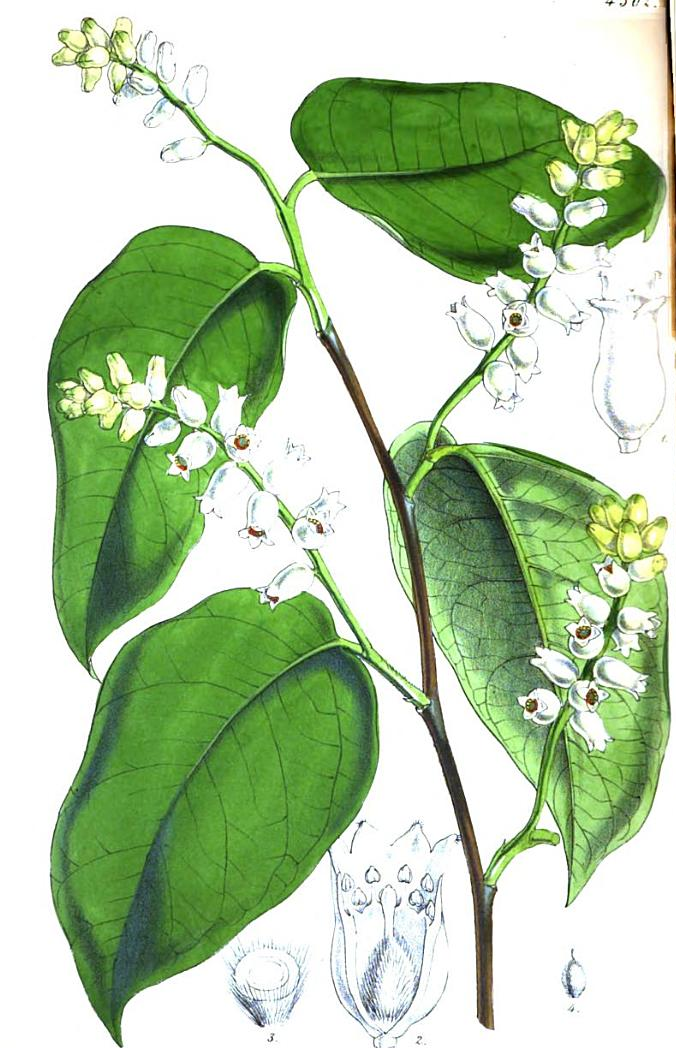
Regardless, most slaves could not afford the cost of imported European and Indian textiles so they looked for affordable and more accessible clothing. Numerous slaves in Jamaica who came from bark-cloth-producing areas in West and Central Africa utilised their ethnobotanical knowledge to obtain plant materials for clothing from local forests. They acquired some knowledge of native plants from the indigenous people of Jamaica, the Taínos, and developed it further.^2^ Beginning in the seventeenth century, many enslaved women in Jamaica began producing bark-cloth for local trade and clothing manufacture. They made the cloth as their ancestors had done in Africa and they passed these skills down to their descendants. The most popular bark-cloth produced in Jamaica was a form of natural lace from the lace-bark tree, Lagetta lagetto, one of three species of the genus Lagetta, belonging to the Thymelaeaceae plant family (Adams 1972: 454). In Jamaica, the tree is simply known as lace-bark and the cloth obtained as lace-bark cloth. From early on, the lace produced was so exquisite and popular that Sir Thomas Lynch, Governor of Jamaica from 1671 to 1674, presented Charles II of England (1660--1685) with a cravat made of lace-bark. This event shed light on the informal lace-bark industry and brought the sector some prestige and praise for the black craftswomen.
Lagetta lagetto has laurel-like leaves of ovate shape which are rounded at the base (fig. 1 and 2). The tree, which takes fifteen to twenty-five years to reach full maturity, ranges in height from six to thirty-two feet and the trunk can be as wide as two feet. It blossoms in April and May, and the flowers are white and produced in terminal racemes.^3^ The lace-bark tree can be found in wet limestone forests far from the coast at an altitude above 1,500 feet, where the annual rainfall is over 75 inches. Within these forests it grows on the hillsides where the soil is graded to bare rock on slopes that form part of the sub-canopy of the forest (Asprey and Robbins 1953: 384).
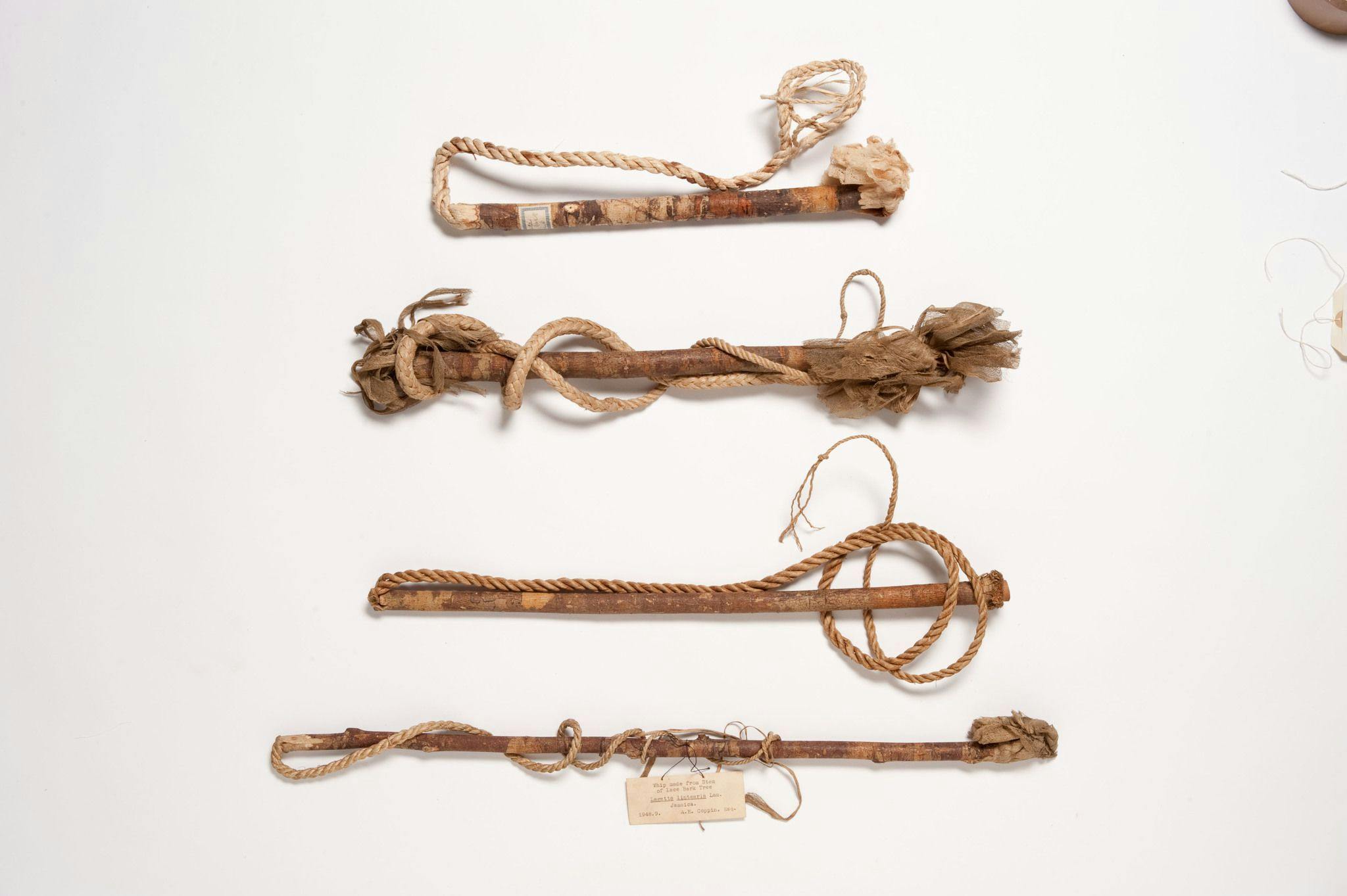
On plantations, the inner bark of the tree was used to make ropes for industrial purposes and to restrain farm animals. Enslaved people used the inner bark and fibres to make objects including hammocks and handwoven baskets, whichadded richness to their lives and contributed to a collective identity. They also used the slender branches of the tree as support sticks for yam vines in vegetable gardens and the bark was valued for its medicinal properties. Lace-bark was used to cure rheumatism and joint pain from yaws. Field slaves used the bark macerated with water to heal skin rashes and sunstroke from working long hours in the hot climate.
Although objects derived from Lagetta lagetto provided some level of comfort and reinforced the humanity of slaves, owners sought to dehumanise their slaves and used the beautiful lace-bark tree to inflict cruel punishment. Enslavers commonly twisted strips of the bark into whips to flog their slaves, and this occurred on a daily basis on plantations and within urban spaces (Buckridge 2016: 71-3) (fig. 3).^4^ At the same time, the texture of the lace-bark fibres caught the attention of many scientists. The physician Sir Hans Sloane (1660--1753) was intrigued by Jamaican lace-bark and remarked in 1725: ‘What is most strange...is that the inward bark is made up of about twelve coats, layers, or tunicles, appearing white and solid, which if cut off for some length, clear'd of its outward cuticula, or bark, and extended by the fingers, the filaments or threads thereof leaving some rhomboidal interstices, greater or smaller according to the dimensions you extend it to, form a web not unlike gause, lace, or thin muslin’ (Sloane 1725: 22).
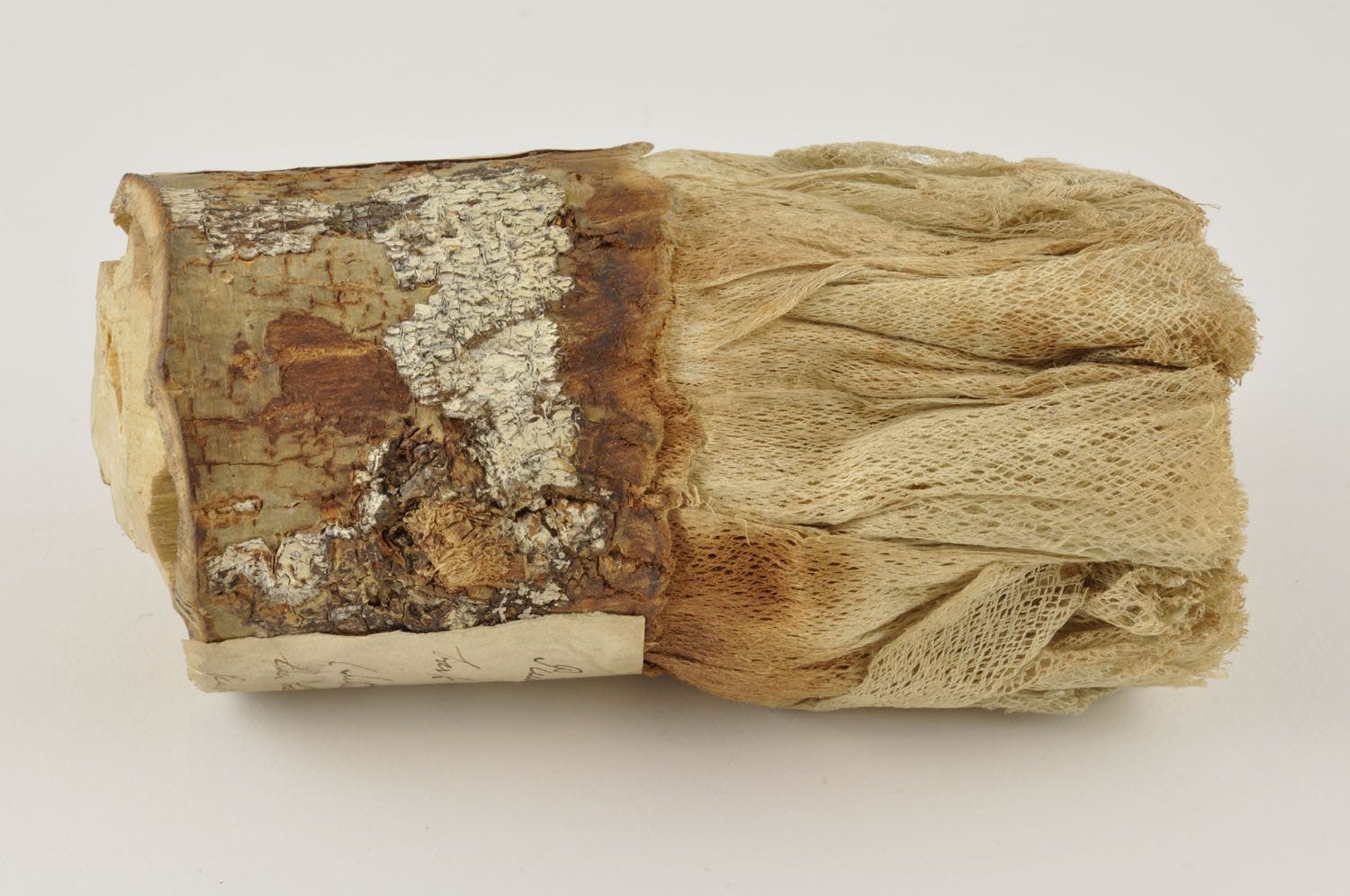
Collection and production of lace-bark cloth were gendered processes. Enslaved and free men of African ancestry from sovereign communities established by runaway slaves or ‘maroons’, searched the forest for mature lace-bark trees to harvest the bark while women produced and traded the lace-bark cloth (Buckridge 2004: 49--57). Unlike other forms of bark-cloth, such as Pacific tapa that required hours of tedious and noisy pounding of the inner bark of the paper mulberry (Broussonetia papyrifera) with wooden mallets to produce malleable cloth, the production of lace-bark was less strenuous. The large branches and trunks of mature lace-bark trees were cut for processing and narrow strips of bark were cut longitudinally from the bole of the tree. Often, entire sections of the bark were removed, thus preventing the tree from regenerating. At times whole trees were cut down. The inner bark was of a fine texture, almost elastic, and very strong, but could be divided into a number of thin filaments. It was soaked in water then teased out with the fingers, extending the lacy fibres over five times the original width of the bark strip. These fibres were then dried and stretched in the sunlight. The end product resembled lace or linen (fig. 4 and 5).
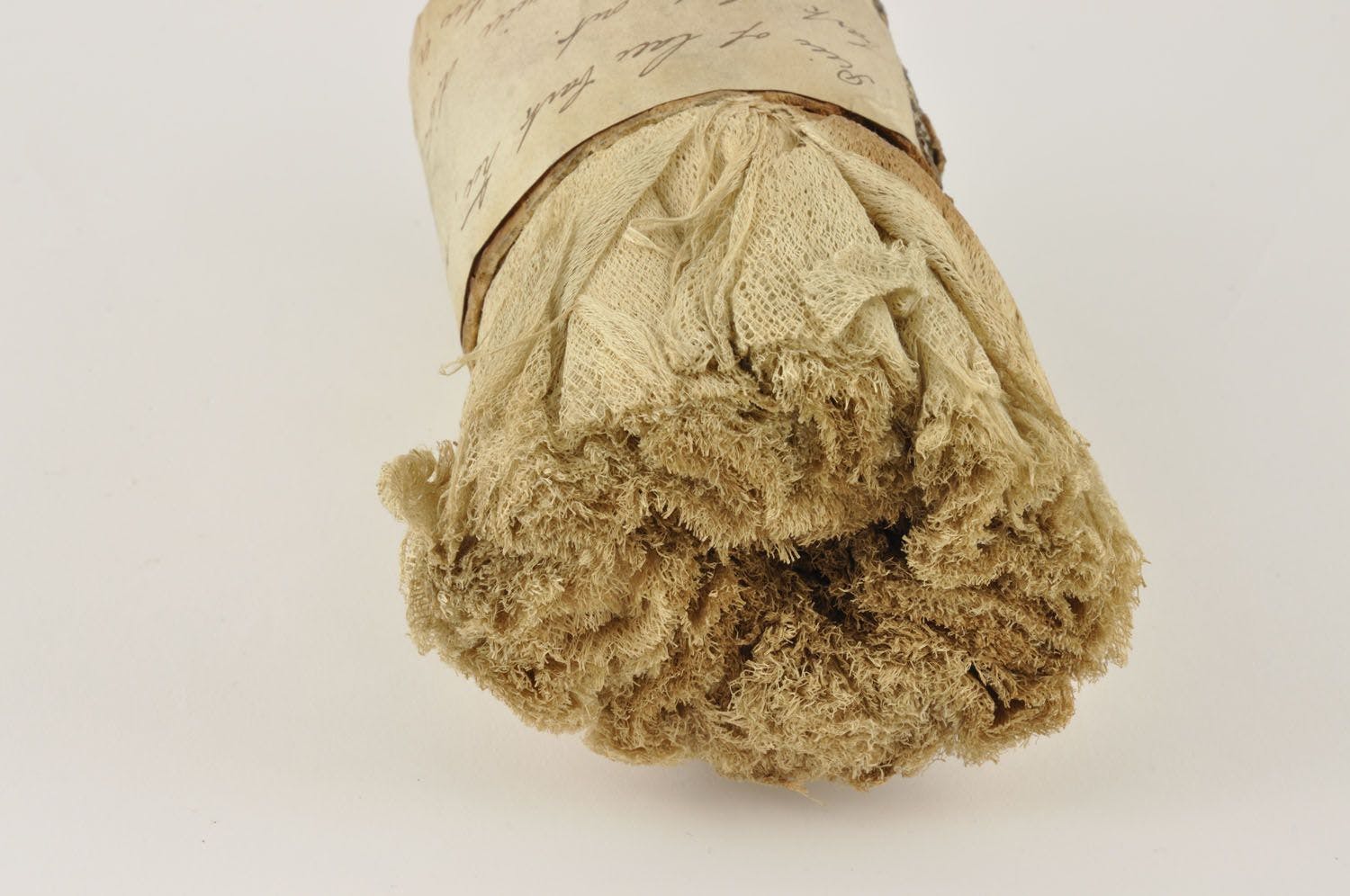
Both freed and enslaved people in Jamaica found lace-bark appealing. Lace-bark clothing kept the body cool in the warm climate and was more accessible and affordable than imported linens and European manufactured lace. Seamstresses found lace-bark desirable because the lace could be dyed and it was pliable, durable and could be sewn into fashionable outfits for customers. Local resident, Edward Long recalled: ‘The ladies [freed and enslaved women] of the island are extremely dexterous in making caps, ruffles, and complete suits of lace with it; in order to bleach it ... It bears washing extremely well ... with common soap ... and is equal to the best artificial lace’ (Long 1774: 747-8). Long's account paints a picture of the fashion sensibilities of slaves and the types of lace-bark accessories they made. His descriptions of lace-bark clothing reflect a high degree of creativity and sophistication in dress design and style among Jamaican women (fig. 6 and 7). Lace-bark was used for accessories such as bonnets, fans, wedding veils, shawls, and slippers overlaid with natural lace. Moreover, apart from clothing, it was used to make doilies and runners to decorate tables and home furniture, for window curtains and space dividers, as well as for sieves in cooking. Natural lace was used as bandages and even as protective coverings or mosquito nets for cradles (Buckridge 2016: 75-8). In addition, it was a great substitute when manufactured European lace was scarce or too expensive (ibid.) The material objects produced from lace-bark were intertwined with enslaved people's lives in a functional manner and simultaneously demonstrated the importance of botany within the slave community and amongst Victorian Jamaicans (Nesbitt 2018; Buckridge 2018).
The emancipation of enslaved people in 1838 brought rapid and major social changes throughout the British Empire including Jamaica. The new social structure in Jamaica included a growing middle class who desired greater access to foreign goods and clothing to reflect their change in circumstances and status as fashionable elite. As ready-made European apparel and manufactured lace became more accessible and affordable, the demand for lace-bark clothing declined. Many black women who were freed chose not to wear lace-bark because it was associated with slavery, poverty and the lower classes. Others were lured and seduced by the abundance of imported fabrics that were once denied to them and the ease with which these items could now be purchased. Some Jamaican women embraced European imported fabrics as a means of elevating their status in the new social order (Buckridge 2016: 119-21).
Natural lace received international recognition during the Great Exhibition of 1851 in London, which highlighted Britain's imperial power and celebrated the industrial achievements of all nations. Jamaica made its debut at the exhibition with a small exhibit of indigenous plant fibres and materials. During the exhibition, Queen Victoria was presented with an entire dress made from Jamaican lace-bark (Palliser 1902: 456). The later emergence of a tourism industry in Jamaica led to an increased interest in Jamaican lace-bark for use in craft items and souvenirs to supply the tourist market.
However, within decades, lace-bark production had become unsustainable due to the increasing demand and by the by the turn of the century the industry collapsed due to exploitation of the tree.Despite international recognition, the lack of oversight by the colonial authorities and local producers, combined with poor harvesting methods, led to the depletion of Lagetta trees in Jamaican forests. The calamity was compounded by urban sprawl and deforestation which deprived the tree of its natural habitat (Long 1774: 736-858; Brennan and Nesbitt 2010-11). The result was catastrophic. By 1906, official reports estimated that ‘only about half a dozen lace-bark trees were left in existence....’ (Anon. 1906: 3) The indigenous lace-bark tree of Jamaica, once ‘in great plenty’ in the seventeenth century, had dwindled to virtual extinction. Today, the ethnobotanical knowledge and the skill of making lace-bark cloth have been lost. In fact, most Jamaicans, except for a few specialists, have never heard of lace-bark (Buckridge 2016: 123-4). In recent years, several Lagetta trees have been spotted in the Cockpit forest region of Jamaica, though these trees are now threatened with extinction from mining and deforestation (Evelyn and Camirand 2003). Although the future of the remaining lace-bark trees is uncertain (Brennan et al. 2013), the lace-bark industry is a fine example of an ethnobotanical tradition that transformed the lives of enslaved women and helped shape Jamaican identity.
References
- Adams, C.D. (1972) Flowering Plants of Jamaica. Kingston, Jamaica: The University of the West Indies Press.
- Anon. (1906) The Lace Bark. Jamaica Gleaner, 16 June 1906, p. 3. Originally published in Royal Magazine, June 1906.
- Asprey, G.F. and R.G. Robbins (1953) The Vegetation of Jamaica. Ecological Monographs 23: 384–85.
- Brennan, Emily and Mark Nesbitt (2010–11) Is Jamaican Lace-Bark (Lagetta lagetto) a Sustainable Material? Text: For the Study of Textile Art, Design, and History 38: 17–23.
- Brennan, Emily, Lori-Ann Harris, and Mark Nesbitt (2013) Object Lesson Jamaican Lace-Bark: Its History and Uncertain Future. Textile History 44: 235–53.
- Buckridge, Steeve (2004) The Language Of Dress: Resistance and Accommodation in Jamaica, 1760–1890. Kingston, Jamaica: The University of the West Indies Press.
- Buckridge, Steeve (2016) African Lace-Bark in the Caribbean: The Construction of Race, Class, and Gender. London: Bloomsbury Press.
- Buckridge, Steeve (2018) Child's Outdoor Cap. Lace-Bark, circa 1850–1861. In Victorian Jamaica, edited by T. Barringer and W. Modest*.* Durham: Duke University Press, pp. 96-8.
- Bush, Barbara (1990) Slave Women in Caribbean Society, 1650–1838. Kingston, Jamaica: Heinemann.
- Evelyn, O.B. and R. Camirand (2003) Forest Cover and Deforestation in Jamaica: An Analysis of Forest Cover Estimates over Time. The International Forestry Review 5: 354–63.
- Foulks, Theodore (1833) Eighteen Months in Jamaica: With Recollections of the Late Rebellion. Oxford: Whittaker, Treacher and Arnott.
- Higman, Barry (1995) Slave Populations of the British Caribbean, 1897–1834. Kingston, Jamaica: The Press University of the West Indies.
- Long, Edward (1774) The History of Jamaica, Vol. 3. London: T. Lowndes.
- Nesbitt, Mark (2018) Botany in Victorian Jamaica. In Victorian Jamaica, edited by T. Barringer and W. Modest*.* Durham: Duke University Press, pp. 209-37.
- Palliser, Mrs. Bury (1902) History of Lace. Fourth edition. London: Sampson, Low, Marston and Company.
- Sloane, Hans (1725) A Voyage to the Islands Madera, Barbados, Nieves, S. Christophers, and Jamaica etc., Vol. 2. London: Printed for the author.
- Stewart, John (1823) A View of The Past and Present State of the Island of Jamaica with Remarks on the Moral and Physical Condition of the Slaves and the Abolition of Slavery in the Colonies. Edinburgh: Oliver and Boyd.
